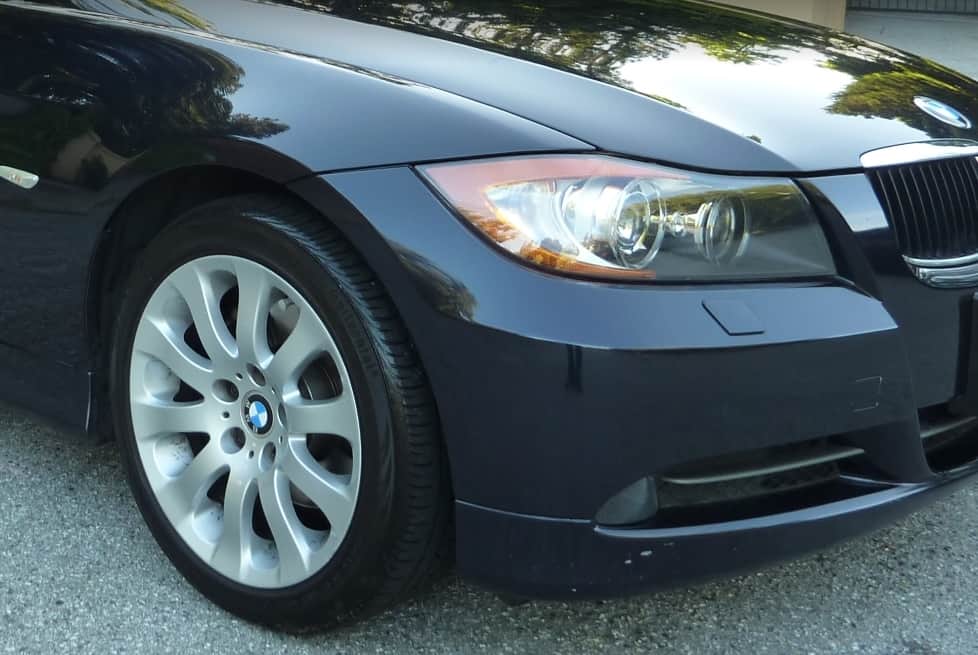ORANGE PEEL ON BMW CARS EXPLAINED
Author: Andre Clemente, Founder of New Old Cars, LLC ©
Proud owner of an E39 540i 6spd
Last updated: July 16, 2020
Don’t bother asking the salesman. The problem is due to the natural chemistry of BMW’s advanced powdered clear coat – a paint technology they have been using since 1998.

You see, the conventional liquid clear coat used on cars from other brands contain solvents. There are different types of solvents for different purposes, but to keep things simple: solvent acts as a leveling agent. It exists to control flow, act as a thinner, and help the paint resist sagging during the drying/curing process. When paint is sprayed on the car, it doesn’t quite hit the surface in a uniform manner (even coming from the factory’s advanced bell cup sprayers), which means ultra-small “hills” and “valleys” form on the surface (we’re talking in the height of microns here). As the solvent begins to evaporate (part of the curing process), it will level out most of this unevenness in the paint. Essentially these “hills” and “valleys” will flow out, leaving a mostly smooth paint finish.
However … BMW’s powdered clear coat has no solvent.
And since powder is a solid and not a liquid, it has no viscosity or flow.
So instead of relying on solvent, BMW has to rely on ultra-high baking temperatures to “melt” (or “fuse”) the powder particles to the body. The temperature required from their ovens can reach almost 100 degrees F higher than what’s typical for conventional liquid clearcoats (which is over 300 degrees F as it is). This is a problem, because now BMW has the difficult job of finding the right balance in curing temperature for both the powder clear coat and the waterborne basecoat that lies underneath (which has not yet fully cured at this stage of the painting process). You see, waterborne paint has different flow properties than the powdered clear coat that sits on top. Too high of a temperature can cause problems for waterborne paints – for instance, it may force the paint to cure (finish cross-linking) before it even has a chance to level itself out. This means the ultra-small “hills” and “valleys” we spoke of earlier have less of a chance to even out into a smooth surface.
The effect is worse with the powdered clear coat on top, which naturally resists flow. The unevenness in the surface doesn’t “level out”, so you get these “clumps” of low and high spots (again, think microns in size).
Say hello to the orange peel.
TAP IMAGE TO REVEAL TEXT
In addition, this powder coat “breakthrough” has cost BMW a lot of money to implement on the their production line. It’s uber expensive, and as a result, no other car company has pursued powdered clear coat technology as of this writing.
So why does BMW swear by it?
The answer is simple: longevity, strength, and a paint that is completely VOC free. BMW’s clear coat can hold up to wear and tear better than any other competitor, and it has more resistance to stone chip damage than any other clear coat in the industry.
Pound for pound, you just can’t beat powder coating when it comes to durability. It’s simply the strongest clear coat there is – period.
In regards to cost, the investment has actually paid off in the long run. 95% of the overspray from powder coating can be recycled, leading to exponentially less waste than conventional clear coats. “BMW Dingolfing has realized actual annual energy cost savings of approximately 25%”, reports PCI Magazine.
Waterborne coatings have their own drawbacks, and considering the EPA has been cracking down on VOC emissions from liquid coatings since 2003, powder coating has a bright future in the automotive paint industry. And guess what? BMW will have more experience in the powder coating field than any other manufacturer, putting them ahead of the game.
Question: On which generation of BMW’s did this problem start?
Answer: The E65/E60/E90 series models (the Bangle Butt era). Even though BMW’s powdered coat clear coat was implemented in 1998 with the E39 5 series and E38 7 series, these two models were “testbeds” and in fact had exceptional paint quality (and durability). As time went on, cost-cutting meant reducing the film build thickness of the clearcoat from the optimal 80-85 microns to 65 microns on the E65 7 series, E60 5 series, and (especially) the E90 3 series. This reduced some of the durability advantages it had over competitors and resulted in a more prominent appearance of orange peel.
Today, BMW has officially achieved what was once thought impossible – a powdered clearcoat thickness equivalent to that of their liquid clearcoat competition (40 to 50 microns). This is why the overall paint thickness of new BMW cars will hover around a mere 120 microns.
Author:
Andre Clemente, Founder of New Old Cars, LLC ©
Proud owner of an E39 540i 6spd
Article last updated: July 16, 2020
Additional Article Sources:
BASF Handbook on Basics of Coating Technology, (3rd ed.)
Film Formation and Surface Tension Studies Of Powder Coatings
Streitberger, Hans-Joachim, and Dössel, Karl-Friedrich. Automotive Paint and Coatings, 2nd Edition. WILEY-VCH Verlag GmBH & Co, 2008.
…and many more! NOC takes incredible pride in posting only the most accurate information with the help of credible sources. Now, because some links are no longer active, not all sources are posted here. These links have been removed from the source’s website for unknown reasons. However, NOC downloads and retains all sources used to stand by every statement in this article. This is done for all articles on our website, and NOC is happy to share this information with the public. Your trust is our number one priority.
